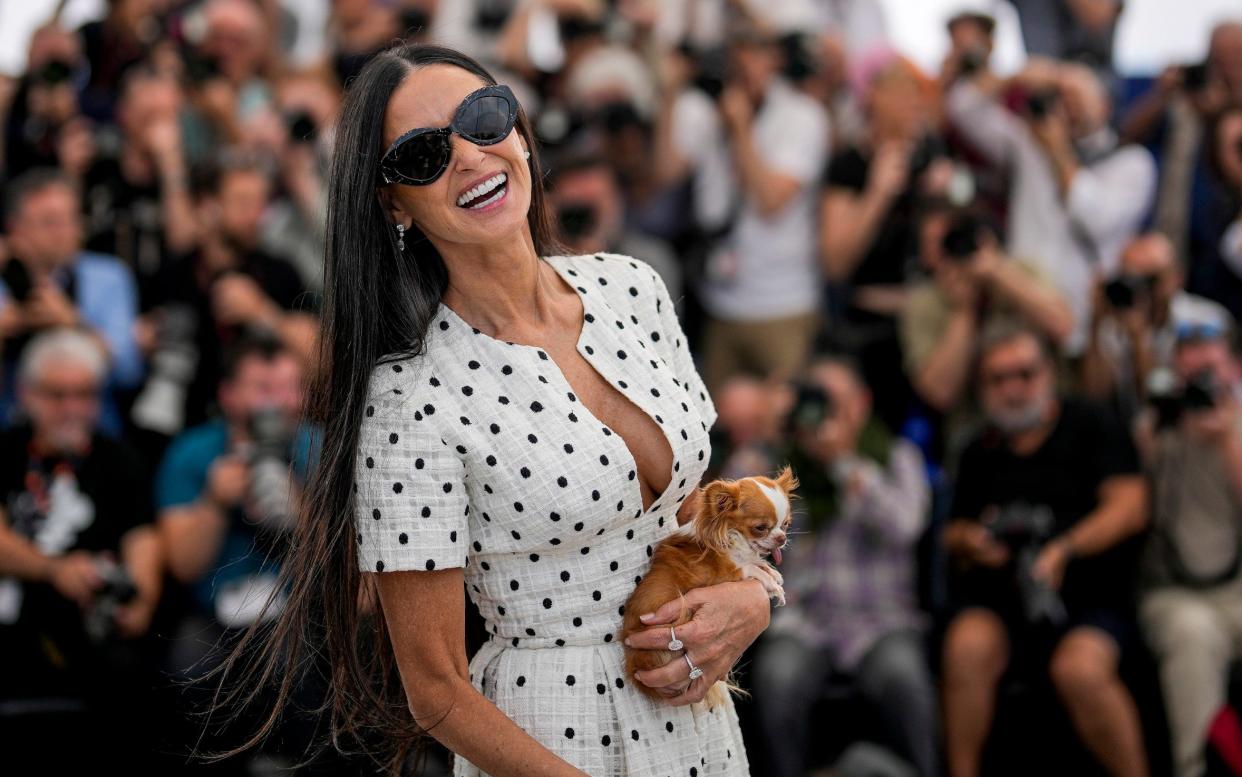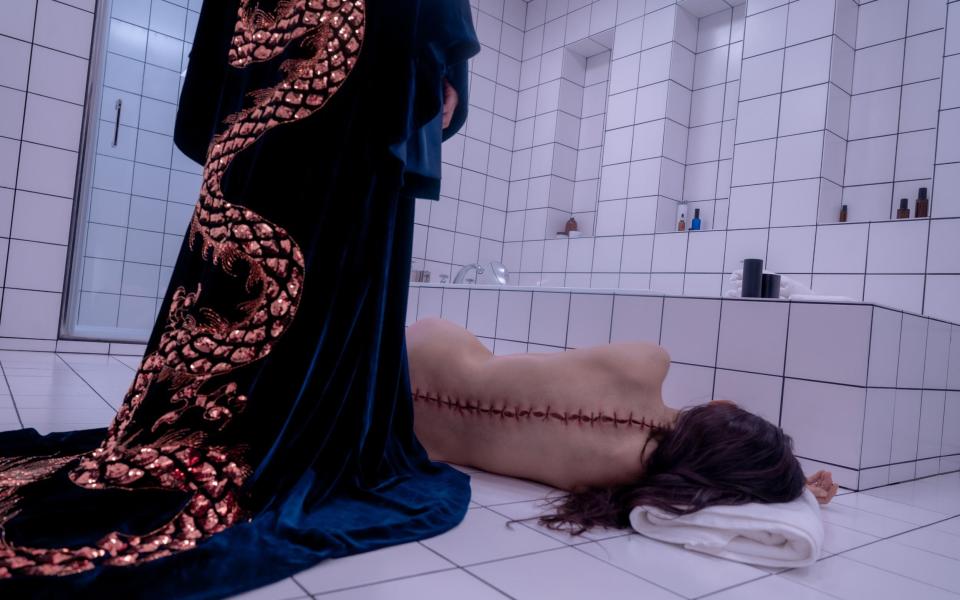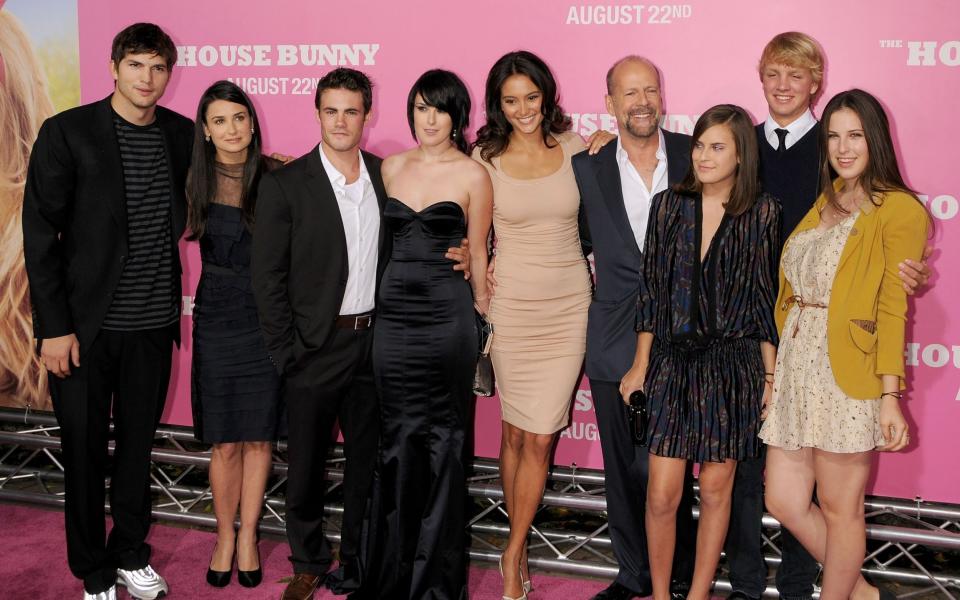How Demi Moore’s triumphant comeback skewers the sexism that Hollywood threw at her

- Oops!Something went wrong.Please try again later.
- Oops!Something went wrong.Please try again later.
A quarter-century since she last made a serious impact on screen, Demi Moore could have stayed faded. But she had other ideas. In The Substance, she has leapt back into focus with a savage, self-lacerating commentary on her own relationship with stardom.
Moore has never done anything to prepare us for this body-horror shocker, a go-for-broke Cannes sensation – both moving and staggeringly gruesome – that makes you rethink her whole career.
To mount this comeback, Moore sets about satirising what she was up against, as one of the most bankable A-list stars of the early 1990s: impossible beauty standards, a finite shelf life, the skeevy dominion of the casting couch. In the ugly glare of a media spotlight that made her notorious, then gave her nicknames, no wonder she suddenly went to ground.
After she’d graced every billboard in various stages of undress to promote her films, the transition was almost Icarus-like – and it happened so abruptly, as soon as Ridley Scott’s G.I. Jane, the last in a ruinous sequence of flops, came out in the summer of 1997.
Since then, what? Moore made a conscious decision to duck away from stardom, give or take playing the baddie in Charlie’s Angels: Full Throttle (2003). She raised a family in between her marriages (to Bruce Willis, then Ashton Kutcher); got big on Twitter with non-profit activism to fight child trafficking; made a surprise appearance at Princess Eugenie’s wedding in 2018; and continued to pop up in a pick-n-mix assortment of movies, united only by their meagre success.
The teenage comedy-drama LOL (2012), in which she played Miley Cyrus’s mom, was actually one of the higher-grossing ones, despite being a total bomb. Name even one more of the 20 films that Moore has technically released in the last 20 years, and you’re doing quite well.
Though she had a lot of say in wanting out, her reasons are emblematic of how tough the industry has always been on its female sex symbols. If you wrote a book about what happens once they’re past 40, she could be the cover girl.
Indeed, this is what The Substance is all about. Moore astounds as Elisabeth Sparkle, a once fêted star – she even won an Oscar, unlike the never-nominated woman playing her – who is brutally put out to pasture, considered too old to keep hosting a dance-workout show (much like the ones Jane Fonda fronted in the 1980s).

Desperate to rejuvenate her career, she resorts to the kind of mystery elixir last seen in the 1992 black comedy Death Becomes Her (which starred Willis, funnily enough). She winds up at the mercy of a self-interested clone (played by Margaret Qualley) who is content to leave the older Elisabeth shrivelling away.
In the thrusting ambition of this Qualley figure, with her FX-amplified bosom much on display, we’re meant to recognise something of the younger Demi, which totally tracks. Perhaps we’re more sympathetic to her in hindsight.
A year after her luminosity in Ghost, the biggest hit of 1990, made her the most sought-after actress in the industry, she did a legendary cover shoot – “More Demi Moore” – with Annie Leibovitz for Vanity Fair, while seven months pregnant with her daughter Scout. She wore nothing but her diamond wedding ring; one hand covered her breasts, the other cradling the bump.
No one remembers the film she was promoting (The Butcher’s Wife), but this cover, which remains one of Leibovitz’s most famous pictures, caused quite a stir. It sparked controversy at the time for pregnancy fetishism/exploitation, but most of the flak, predictably, was directed at Moore herself, for being the one who disrobed.
She could only field such critiques with hurt puzzlement. Besides, it was meant as juicy publicity for her box-office heyday, brief as that was: post-Ghost, the only big ones in the “plus” column would be A Few Good Men (1992), Indecent Proposal (1993) and Disclosure (1994).
The latter two may have been quick-to-date erotic thrillers relying heavily on her sex appeal. But all three films had male stars credited above her – a form of Hollywood glass ceiling Moore was commendably eager to smash through.
She didn’t get much credit for it back then. “What’s the point of Demi Moore?”, began the New Yorker’s Anthony Lane in his review of her next one, The Scarlet Letter (1995), having already lobbed a cruel zinger in his piece on Indecent Proposal: “How much would you pay for an evening with Demi Moore’s mind?”
A perceived desperation to top the billing sent Moore into a tailspin. The Scarlet Letter was her nadir, a softcore bodice-ripper that critics tore apart at the seams, treating her Hawthorne heroine as little more than the village slut. A further double-bill of duds followed in 1996: The Juror and Striptease, for which she jointly won the Golden Raspberry for Worst Actress.
Those Razzie voters really had it in for Moore throughout this period – she’s perfectly fine in The Juror! – but they were also bellwethers of a public turning sour. She could come across as brittly in interviews, without the warm approachability of Julia Roberts. She turned down While You Were Sleeping (1995) because the money wasn’t enough, giving next choice Sandra Bullock a leg-up.

Moore and Willis, to whom she stayed married until 2000, were already rolling in it, living with their children on a ranch in the small town of Hailey, Idaho. They invested so lavishly in this place – buying up a diner, a club, in time an airstrip, and filling a renovated Victorian mansion with Moore’s collection of antique dolls – that people started calling it “Planet Haileywood”.
The capper was Moore’s much-publicised $12.5m salary for Striptease, which made her Hollywood’s highest-paid actress at the time. That film, a tatty crime comedy about lap-dancing, was a woeful choice for this crowning moment.
Yet again, she was nude on the posters. Only ticket buyers would get to see the breast enhancements she’d had that year. Striptease was savaged, and the tabloids dubbed her “Gimme Moore”.
The gossip got bitchier the less she wore. Gorgeous, yes, and uninhibited about screen sex, but could she act? When Moore shaved off her hair for G.I. Jane, doing one-armed push-ups on Letterman and flinging herself boldly into a tough action role, acclaim was anticipated, yet she reaped none.
She would blame a hangover effect from the Striptease payday. “In a sense, Striptease was a film where women felt I betrayed them,” she speculated in 2009. “G.I. Jane is a film where men felt I betrayed them. The focus went on that paycheck.”
We know from her 2019 memoir Inside Out about the many other problems that Moore was battling, including chronic addictions to alcohol and cocaine; she also opened up about her “rape and devastating betrayal” at age 15, when her mother Virginia (who died in 1998) accepted $500 from a landlord who attacked her at home.
A childhood surrounded by heavy drinking took its toll. Moore checked into rehab as a rising star in 1985, a consequence of Joel Schumacher threatening to fire her for being high on the set of his gang’s-all-here Brat Pack melodrama St Elmo’s Fire.
She would maintain sobriety for 20 years, only falling off the wagon after she’d married Kutcher, the goofy jock she started dating in 2003. Kutcher was 25 when they met; Moore was 40, and still raising her children from Willis, who merrily came to the couple’s Beverly Hills wedding in 2005.
While this trio tried to make a valiant go of things as a modern family unit, the “cougar” jibes in red-tops gained a demeaning edge. Moore would admit that the new marriage made her feel codependent, triggering her addictions all over again. (She and Kutcher divorced in 2013.)
After all this time, what invites wild applause in The Substance – much like The Wrestler did for Mickey Rourke or Birdman for Michael Keaton – is how it functions for Moore as a long, hard look in the mirror. For us, it’s a revelation. In three or four of the best scenes, we catch the 61-year-old actress judging her reflection – often fully naked.
Despite looking phenomenal, she’s her own harshest critic – and she is not short here of other enemies scheming to throw her in the garbage. Writer-director Coralie Fargeat may not engineer any redemption for Elisabeth (far, far from it), but the underlying point is to make you feel things for Demi Moore that you’ve never felt before. Therein lies her triumph.
When she was striving to be the hottest star in the firmament, there was something about Moore’s willed hardness that didn’t let us in. The effort seemed steely, conspicuous. With age has come vulnerability; daring, too. Dropping her defences to act afraid, she becomes wonderfully empathetic for the first time since Ghost, and deserving of our affection.

